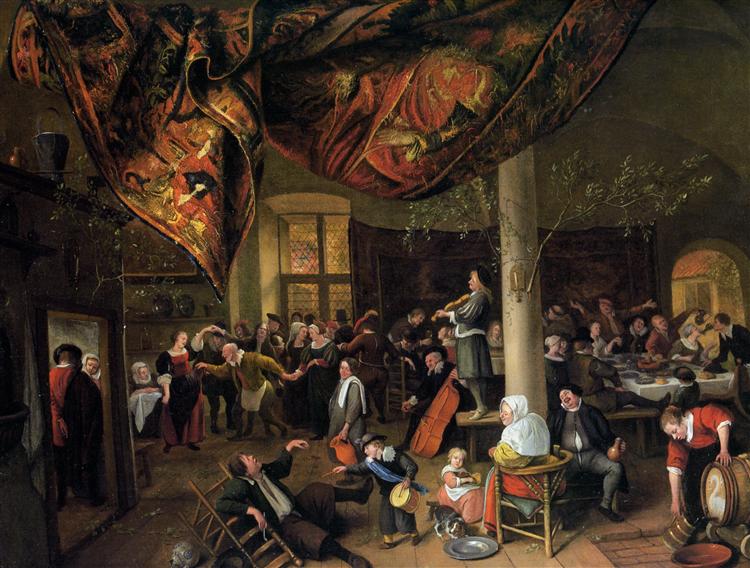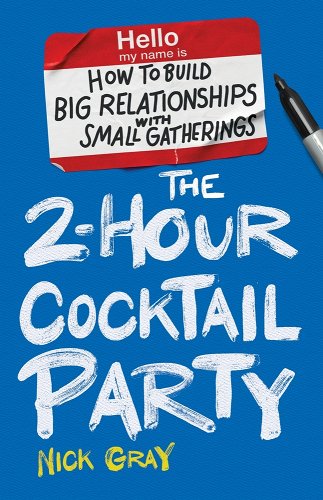Fairfax, VA. Last week, I did something I have never done before: I hosted a cocktail party at my house. I was inspired by Nick Gray’s book The 2-Hour Cocktail Party, which is both a pitch for hosting and a formula for how to do it. Gray’s recipe for a great party includes name tags, a harmonica, ice breakers, and a hard start and stop time. If that strikes you as more dorky than fun, or you think hosting is not for you, I totally understand. Hear me out.
If you follow his instructions to the letter (which I did), you may feel a bit foolish for how seriously you are taking a casual party. You will create an event page to collect RSVPs, send out three reminder emails, and even write short guest bios. This approach is at odds with the prevailing social norms of “too cool to care” and FOMO-induced commitment-phobia. By inviting people into your home for an event that you clearly planned in advance, you make yourself vulnerable.
And this is the essence of Gray’s approach: an extreme host makes for comfortable guests. If I am ecstatic, you can just be happy to be here. My structure may border on fanatical, but the mandatory name tags let you focus on talking rather than remembering twenty new names. You may roll your eyes when I blow my party harmonica to start an icebreaker, but now you know who else is in the room, and you can start a new conversation without having to awkwardly break off your old one to break into a new, preexisting, and possibly worse one. As host, you must be like Colonel Jessup from A Few Good Men: my existence, while grotesque and incomprehensible to you, saves parties.
Even though “cocktail” is in the title, there are no recipes in this book. “Cocktail party” just evokes the right image: not a blowout, a dinner party, or a themed event. Just standing, talking, and mingling with new people. Judging from my prompt RSVPs, there is some untapped demand for a chance to make new connections. I am so accustomed to the interminable back-and-forth of scheduling with a friend, that simply inviting thirty people to get twenty confirmed guests was refreshingly fun and easy.
Besides relentless enthusiasm, Gray’s strategy is balancing an easy yes with a meaningful opt in. To make it an easy yes, you schedule for a Monday, Tuesday, or Wednesday evening: days less likely to conflict with other events. Then, you ask guests individually “I’m having a party on Tuesday the 18th. Can I send you the info?” not “Will you come?” Everyone likes getting invited without the pressure of an immediate decision.
However, by sending a link to your event page, you require them to opt in once by clicking the link and then again by RSVPing. This creates some buy-in on their part. They have put their name down as “Attending” for all other guests to see. That event page also allows you to disclose some of the quirks of your party—like name tags and ice breakers—so everyone opts in to your unique party format.
Overall, the hardest part I had hosting my first party was that I am not Nick Gray. He will wear a neon green hat sideways while exuding pep to model how hosts should take a group photo. It is easy to imagine him quieting a room with a harmonica or sending reminder emails with cute GIFs and emojis. However, I will say that the name tags, ice breakers, and the harmonica—all of the things I was skeptical of—were well-received, even with my more moderate clothing and energy. It will take more parties to determine the line between Nick’s idiosyncrasies and best party practices.
I say “Nick” because I have actually spoken with him three times for nearly an hour in total. This was not through dogged journalism. He gives his personal number out to any newsletter subscribers who want to host parties. This is unusual since he’s built and sold two multimillion dollar businesses. Talking with first time hosts like me seems a low ROI activity for someone who presumably understands ROI.
When I asked him about this, he said that we are in a loneliness epidemic, a “friendship recession,” and helping people host gatherings is among the most meaningful work that he has ever done. Since he does not have to work currently, this is what he wants to do. He often talks about past awkward networking events or dark, nighttime parties in NYC that left him feeling disconnected and lonely. He started throwing these parties to bring a bit more thoughtfulness to growing his relationships, and he wants to pass that knowledge along. His goal is to guide 500 hosts through their first party, and he recently passed 200.
Hosting a party like this is hard. It is hard to put yourself out there, colliding worlds is nerve wracking, and there are logistics and expenses that come with hosting (although my party was less than $100). But, it is also deeply satisfying bringing people together to talk. As someone who squirms every time I see a couple or family all quietly tapping their cell phones, a room of twenty people talking is a beautiful sight.
It is easy to despair at our polarized and atomized society, but I appreciate Gray’s book for giving a clear, achievable step for building community and making friends. Hosting a cocktail party is not the only way to do those things, but for me, it was a case of “the best plan is the one you actually do.” I would encourage you to do the same.
The 2-Hour Cocktail Party is available on Bookshop, or you can get an executive summary of the book on his party website.
Image Credit: Jan Steen, “A Village Wedding Feast with Revellers and a Dancing Party.”






2 comments
Brian D Miller
I didn’t quite get this piece when I first read it. Then I realized it was because I was thinking of cocktail hour, not “party”. The Hour starts a bit more solemn as one waits for the weight of the day to slacken, preferably with an Old Fashioned liberally made and lightly garnished with a sliver of orange peel. It is best honored with company, but never to exceed four people in total (possibly six of the right sort). But the ritual can also be performed alone, according to ones need. The stepfather of my beloved observed this rite scrupulously each evening with two tall boys and a dime store cigar. He was a physician working in the state prison system during the height of the AIDS epidemic. He uttered not a word to anyone as he came in the house, grabbed the necessaries to restore his soul, and exited to the screened patio. He used that time apparently to great effect, emerging after an hour ready to interact with his family in peace. Cocktail hour as I seem to recall Mr. Berry saying at a conference, is both a pleasure and often an obligation. But it ends, not with group photos but with harmony among those you have chosen to spend that time.
Christian
Good stuff. We developed a new approach to the cocktail party out of necessity during the pandemic: the driveway happy hour. Even with the restoration of the ability to mingle indoors we’ve kept it going. The outdoor format seems to have a number of potential benefits. People are more inclined to host because they don’t have to deep clean their houses in anticipation of having people over. Guests with children can attend because the kids can play games on the lawn while the adults talk. The fact that it’s outdoors and out front means that we pick up unexpected attendees from neighbors who are walking by and can be encouraged to join in.
Comments are closed.